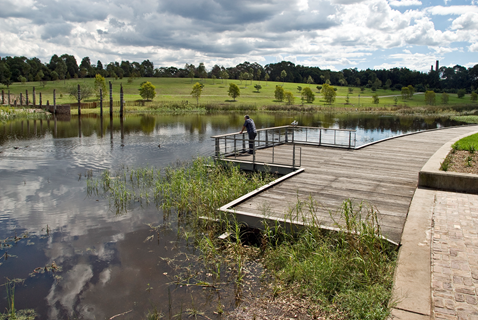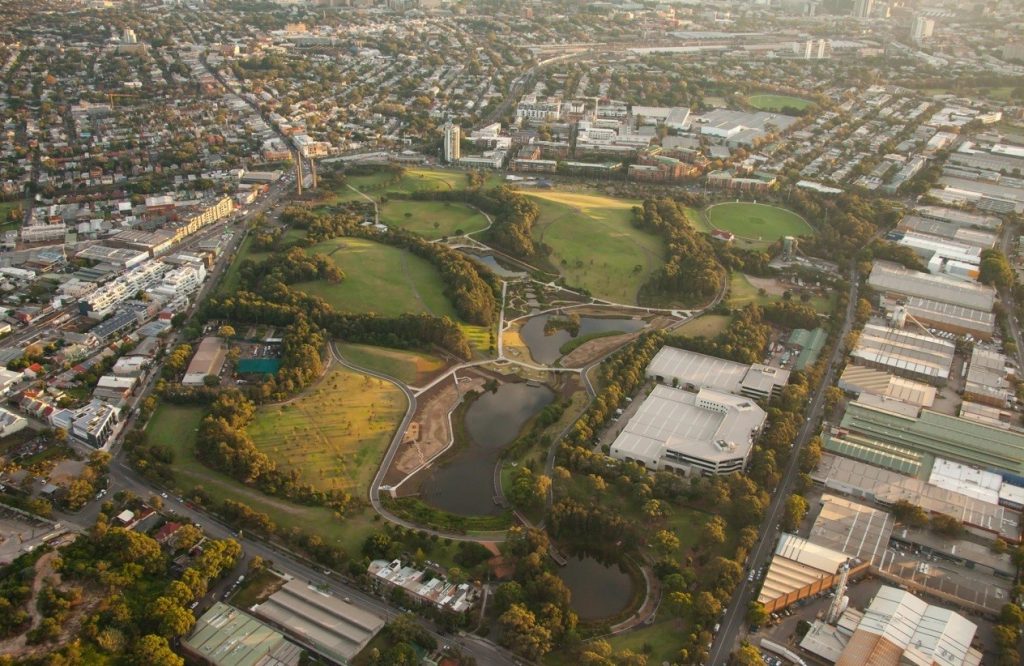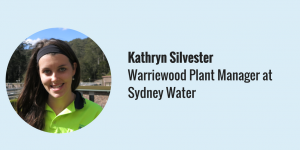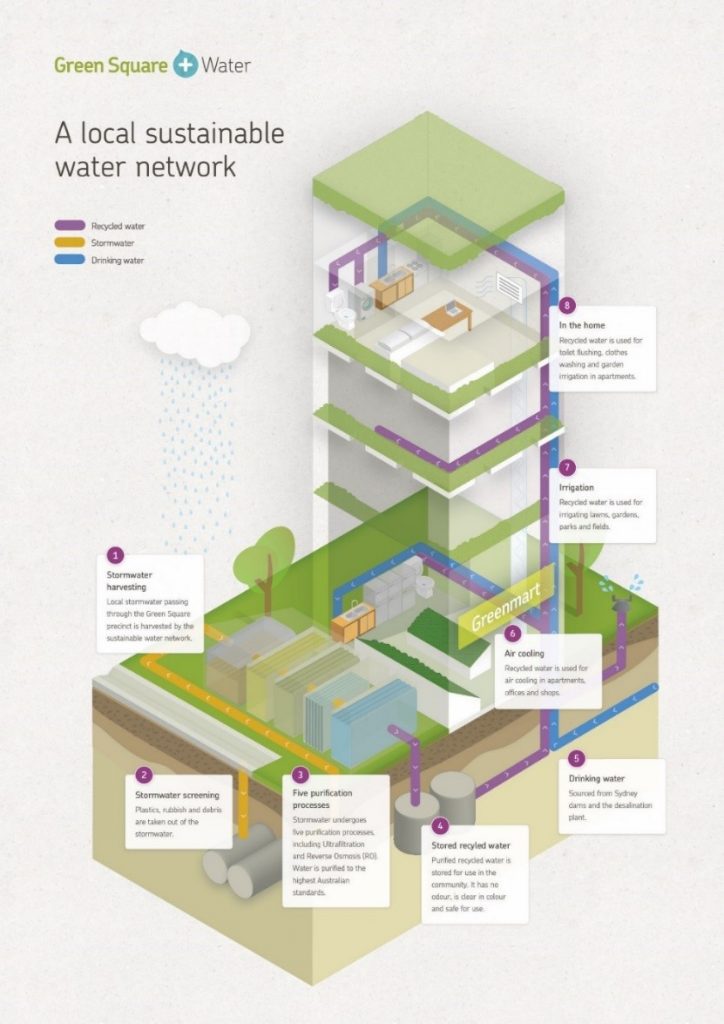A resilient, cool and green city
How the Australian harbour city is changing its behaviour to water
The millennium drought affected all of Australia, and certainly it’s star city Sydney. This drought caused serious water security concerns for Sydney in the past, and further strain on the current water supplies is expected into the future. The predicted impacts of climate change and population growth translate into an increase by 30% of current water demand by 2030. In the face of these challenges, the City of Sydney is developing a strategy to drought-proof the city and “keep it green and cool, “starting with a target to maintain the potable water use at the 2006 consumption level.
The city is transforming into a water sensitive city that is resilient, cool, green, and productive. The water management approach to reduce vulnerability to droughts in the future include: using less water through behaviour change, followed by using water efficient fixtures and fittings, reducing stormwater pollution, minimising local flood risk, and enhancing greening and urban cooling through retrofitting the stormwater management network with raingardens, wetlands, swales and gross pollutant traps.
Resilience across the Nation
A key component of the City of Sydney’s plan initiated in 2010support of the Federal and State Governments is the commitment to be a water sensitive city. This is captured in a series of targets across the theme to “build resilience to the predicted impacts of climate change, we need to keep our city cool and green. We aim to minimise use of potable water through efficiency and by capturing alternative water sources to recycle for non-potable purposes.” Green Environmental Sustainability Progress Report 2017
The approach is to drought-proof the city. Waterway health will be improved and potable water supplies will be safe- guarded for use in the next century and beyond.
Securing Water Resources for the Future
The City’s Decentralised Water Master Plan identifies actions and investments to reduce the City’s reliance on potable water through retrofitting the most resource intensive properties, including water efficiency in all new constructions, using recycled water in parks and in buildings, and harvesting stormwater. Parks are to be equipped with new water use data monitoring and analysis systems by June 2017 to guide efficiency measures. 
Sydney’s approach is to secure water availability when it is hot and dry. The vision embraces flood risk mitigation with the floodplain management plan, which is implemented in partnership between the City of Sydney and the State Government. It aims to get stormwater safely out of vulnerable places in each catchment, while ensuring it can be reused.
Case Study: Green Square Flood Management
The first Floodplain Risk Management Plan and alliance partnership was approved by the City and State Government in June 2013. Its implementation has begun with the Green Square Trunk Drain. The $100 million drainage work will be completed in 2017, draining floodwaters away from homes, businesses and roads. The City of Sydney is also delivering up to 270 million litres per year of recycled stormwater to the new buildings and open spaces in the Green Square Town Centre, saving precious drinking water.
4 Levels of Action - Sydney’s Progress Towards the Principles
Regenerative Water Services
• Our approach will drought-proof our city to ensure we can use water when it is hot and dry. Our waterway health will be improved and potable water supplies will be safe- guarded for use in the next century and beyond.
• Compensating the anticipated 30% increase in water demand by 2030 through reducing consumption and using alternate non-potable supplies.
• Retrofitting the stormwater management system with raingardens, wetlands, bio swales and gross pollutant traps to reduce stormwater pollution, enhance greening and urban cooling and to and minimize local flood risk.
• Water efficient fixtures and fittings through council’s internal policy management.
• Upgrading park irrigation systems
• Smart meters to detect and fix leaks
• Targets in city plan for energy and water efficiency of new buildings, rating tool for residential apartments, water pricing that supports efficiency and the viability of alternative water sources
• Alternative water sources including stormwater, rainwater and wastewater for non-potable purposes
• Decentralised Water Master Plan
• Environmental Sustainability Strategy and Action Plan 2016 – 2021
• Water efficiency, water recycling and water sensitive urban design will relieve pressure on the potable water supply and ensure that the City can support its growing population in the face of climate change
Water Sensitive Urban Design
• Green Square Project
• City Floodplain Management Plans
• Sydney Park wetland and the Drying Green Park wetland introduce water in the landscape
• Raingardens integrated into footpaths and public open space
• Sustainable procurement guidelines, sustainable design guidelines
Basin Connected Cities
• Maintain the 2006 potable water supply quantities by 2030
• Harvesting initiatives endorsed by the State Government’s Office of Water through collaboration
• Working with neighbouring Councils in the greater catchment to improve the health of waterways in the City
• First Floodplain Risk Management Plan 2013
• Adapting to Climate Change strategy (adopted in 2015) that looks to 2070 to assess and adapt to the risks posed by climate change for the city
Water-Wise Communities
• Sustainability programs to empower residents and businesses Smart Green Business, Better Buildings Partnership, City Switch, Smart Green Apartments and Green Villages programs. Environmental performance grants and recycled water schemes
• Increasing internal skills and capabilities, eg. Sustainability Strategy and Green Infrastructure teams
• Governance frameworks to ensure transdisciplinary teams from planning stages.
• Working with all government levels to influence water sensitive outcomes in urban renewal areas
• Policy and regulatory frameworks are developed to enable the vision
• The City is advocating for change within state and federal government
• Strong vision with measureable targets
Blog Posts
Latest opinions and insights relevant to the water sector




